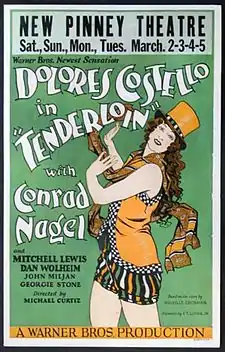Tenderloin (film)
Tenderloin is a 1928 American part-talkie crime film directed by Michael Curtiz and starring Dolores Costello.[3] While the film was a part-talkie, it was mostly a silent film with a synchronized musical score and sound effects on Vitaphone discs.[4] It was produced and released by Warner Bros. Tenderloin is considered a lost film, with no prints currently known to exist.[5][6][1]
| Tenderloin | |
|---|---|
 theatrical release poster | |
| Directed by | Michael Curtiz |
| Written by | Edward T. Lowe Jr. (scenario, adaptation, dialogue & titles) Joseph Jackson (dialogue & titles) |
| Story by | "Melvin Crossman" (Darryl Zanuck) |
| Starring | Dolores Costello |
| Cinematography | Hal Mohr |
| Edited by | Ralph Dawson |
Production company | |
| Distributed by | Warner Bros. Pictures |
Release dates |
|
Running time | 85 minutes |
| Country | United States |
| Language | English |
| Budget | $188,000[2] |
| Box office | $985,000[2] |
Plot
Rose Shannon (Dolores Costello), a dancing girl at "Kelly's," in the "Tenderloin" district of New York City, worships at a distance Chuck White (Conrad Nagel), a younger member of the gang that uses it as their hangout. Chuck's interest in her is as just another toy to play with. Rose is implicated in a crime which she knows nothing about. The police pick her up, and the gang sends Chuck to take care of her in the event she may know or disclose something that will implicate the gang.
Cast
- Dolores Costello as Rose Shannon
- Conrad Nagel as Chuck White
- George E. Stone as "Sparrow"
- Mitchell Lewis as The professor
- Dan Wolheim as "Lefty"
- Pat Hartigan as "The Mug"
- Fred Kelsey as Detective Simpson
- G. Raymond Nye as Cowles
- Evelyn Pierce as Bobbie
- Dorothy Vernon as Aunt Molly
- John Miljan as bank teller
Premiere Vitaphone short subjects
Tenderloin premiered at the Warners' Theatre in New York City on March 14, 1928.
| Title | Year |
|---|---|
| Orpheus in the Underworld Overture | 1927 |
| Beniamino Gigli & Giuseppe de Luca in Duet from Act 1 of "The Pearl Fishers" (Les pêcheurs de perles) | 1927 |
| Abe Lyman and His Orchestra | 1928 |
| Xavier Cugat and His Gigolos ("A Spanish Ensemble”) | 1928 |
| Adele Rowland in "Stories in Song" | 1928 |
Production
Tenderloin was the second Vitaphone feature with talking sequences that Warner Bros. released, five months after The Jazz Singer. The film contained 15 minutes of spoken dialog, and Warners promoted it as the first film in which actors actually spoke their roles. Reportedly, at the film's premiere, the feature was met with derisive laughter as a result of the film's stilted dialogue, resulting in two of the four talking sequences being eliminated during the first week of the film's premiere run.[7] Critic Harriette Underhill wrote that the "screen talking devices give the characters a certain lisp, slightly detracts from the serious effect."[8]
Box Office
According to Warner Bros records the film earned $889,000 domestically and $96,000 foreign.[2]
See also
References
- Tenderloin at the American Film Institute Catalog
- Warner Bros financial information in The William Shaefer Ledger. See Appendix 1, Historical Journal of Film, Radio and Television, (1995) 15:sup1, 1-31 p 6 DOI: 10.1080/01439689508604551
- "Tenderloin". lcweb2.loc.gov. May 22, 2018.
- Progressive Silent Film List: Tenderloin at silentera.com
- American Film Institute (1971) The American Film Institute Catalog Feature Films: 1921-30
- "Lost Film Files - Warner". www.silentsaregolden.com.
- "Tenderloin (1928) - Notes - TCM.com". Turner Classic Movies.
- (26 March 1928). Cinema: The New Pictures, Time
Further reading
- Hall, Mordaunt (March 15, 1928) "A Film with Dialogue" (review) The New York Times